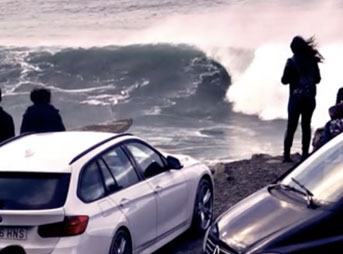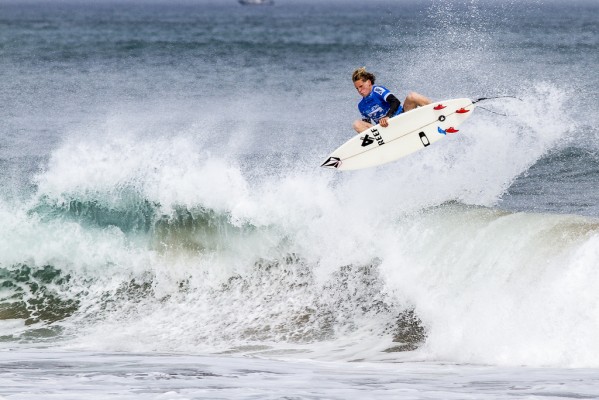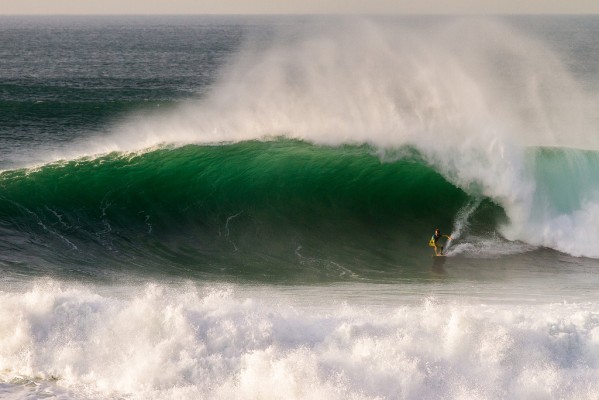
Mundaka firing. Photo: Oscar Martinez Diego
The Iberian Peninsula is home to some of the sweetest surfing spots in Europe. With almost 3,100 miles (5,000 kilometers) of coastline, including the Canary Islands, Spain is renowned for its rich culture, gripping history, amazing food, and of course its world-class surf.
If you’re planning a surf trip to Spain, make sure you visit the Atlantic coastline, all 441 miles (710 kilometers) of it, instead of the Mediterranean coast. Even though there are a few spots on the eastern side of Spain, swells aren’t nearly as consistent as they are on the northwestern coast.
The weather in Spain is warm and pleasant all year and dry during winter months, which makes it a popular cold-water surfing destination. You will find world-class river mouths, a great variety of waves for all levels of surfers, and uncrowded spots worth exploring. In Northern Spain, Basque Country offers all types of waves produced by the Bay of Biscay. Further west, Cantabria and Asturias offer a good number of quality spots and big waves, while Galicia is the place to go to experience the power of the Atlantic Ocean firsthand. Even though quality swells are not consistent on the Mediterranean coast, surfing is pretty neat near Barcelona.
Please note that while you can find decent surf in Spain all year round, it is during colder months that the Atlantic shows its true colors. The beaches are anything but calm between September and April. Meanwhile, during summer months, beginner surfers can find plenty of warm water waves to polish up their skills. So here are useful insights on the best waves in Spain and when to catch them:
12. Surfing near Barcelona
Patience is a virtue when it comes to surfing on the Mediterranean coast of Spain. South and north of Barcelona, surfers will find an abundance of surfing, kitesurfing, and windsurfing opportunities.
South of Barcelona surf spots:
Garraf – A-frame beach break for all levels; uncrowded.
El Prat – A-frame beach break; usually crowded.
The Cemetery – a favorite spot among longboarders.
North of Barcelona surf spots:
Río Besòs – a right-hand point break at the mouth of the river Besòs for more advanced surfers; uncrowded.
Masnou – left-hand beach break; longest waves in the area.
Montgat – A-frame beach break; uncrowded.
Best time to surf: October through March.
11. Surfing in Andalusia
In Southern Spain, which is open to both the Atlantic and the Mediterranean, Andalusia is famous for its strong winds. This is why kitesurfing and windsurfing are far more popular in this part than anywhere else in Spain. However, Andalusia has some cool surf spots too, mainly centered on the coast of La Janda, in the province of Cadiz.
Los Caños – A-frame reef break for experienced surfers.
El Palmar – A-frame sandbar break for all levels.
El Castillo – right-hand reef break for experienced surfers.
Playa de Los Lances – A-frame beach break for all levels.
Best time to surf in Andalusia: winter and spring.
Best time for kitesurfing/windsurfing in Andalusia: winds are strong all year-round, but prime time is between May and October.
10. Playa de Somo – consistent beach break (all levels)
If you’re looking for the perfect surf beach in Spain, you can’t go wrong with Playa de Somo. The quiet surf town of Somo, close to Cantabria region’s capital city Santander, is home to one of the country’s longest beach breaks and is excellent for beginners and intermediates. It’s a swell magnet and the consistent beach break here produces A-frame waves up to 6 ft (1.8 m). There are also surf shops, campsites, surf schools, bars and restaurants to chill in the evening.
Best time to surf: November through April.
9. Roca Puta – one of the best big waves in the world (advanced surfers)

Near Zarautz in Basque Country, Roca Puta is an internationally renowned powerful right. If you haven’t already guessed what its name means, let me spell it for you in English: Roca Puta translates to “Slut Rock.” It surely is the most indelicately named big wave in the world. According to well-traveled surfers, it is also one of the best.
Surrounded by picturesque hills, the 1.5-mile (2.5-kilometer) beach at Roca Puta attracts experienced surfers. The heavy waves here break in shallow water close to the rocks, which makes the place pretty darn extreme.
Best time to surf: October through April.
8. Isla de Santa Marina (intermediate to experts)
The uninhabited island of Santa Marina in Northern Spain is the largest of the Cantabrian islands. Between the island itself and the mainland lies one of Spain’s best right-hand reef breaks. It only starts to work from 5 feet (1.5 meters) upwards and can produce big waves up to 15 ft (4.6 m). It works on all tides, but the rocks on the bottom become a problem at low tides.
The powerful, hollow, world-class waves here have some barreling sections for experienced surfers to play with. Beginners are advised to keep their distance and can head to the nearby beginner-friendly Playa de Somo instead.
Best time to surf: November through April.
7. Sopelana – one of Spain’s most popular surfing beaches (all levels)

An alluring surfing beach, Basque Country’s Sopelana is home to a wide variety of waves: lefts and rights, some long, others fast, and some incredibly hollow. The quality A-frame waves here make Sopelana one of the most crowded surfing spots in the country. Thanks to its popularity, you will find every facility you could think of: surf schools, surf shops, campsites, bars, and restaurants.
Best time to surf: October through April, on small to medium swells.
6. Playa de Razo – perfect A-frame waves (all levels)
A big, open beach break where crowds are rarely an issue, Playa de Razo is a great place to sample the surf in the North West of Spain. Galicia is said to have the best surf in Europe, and Playa de Razo’s long stretch of fine white sandy beach is home to numerous sandbanks, which produce a variety of A-frame waves that are ideal for all levels.
Thanks to its exposure, consistency is guaranteed. Even the smallest of swells still produce nice waves. Playa de Razo is one of the best places to learn to surf in Spain, and you will find plenty of campsites and surf schools here.
Best time to surf: September through April
5. Playa de Rodiles – Mundaka’s little sister (intermediate to advanced surfers)
In the Asturias region on the northwestern coast of Spain, Playa de Rodiles is confined by steep cliffs dropping straight into the Atlantic Ocean. Against this stunning backdrop, a world-class river mouth awaits experienced surfers. Shorter than the famous Mundaka, this left-hand hollow wave reaches over 10 ft (3 m) on its good days and is just as fun.
Due to the strong rips, this surf spot is recommended for intermediate to advanced surfers. Famous for its difficult surf and quite popular among locals, Playa de Rodiles can get crowded.
Best time to surf: November through April.
4. El Brusco – one of Spain’s best beach breaks (intermediate to pro surfers)
The Spanish cousin of the world-class Supertubos break in Portugal, El Brusco produces epic right and left barrels. During summer months, Noja, in the Cantabria region in Northern Spain, is a lively beach resort. During colder months, it becomes a ghost town. However, this does not make it uncrowded. The hollow beach break here is one of Spain’s finest and most sought after.
Best time to surf: October through April.
3. Zarautz – Spain’s surfing capital (all levels)
Zarautz is where surfing in Spain took off in the 1960s. Being one of the country’s best all around surf beaches and its biggest surf town, Zarautz is a great place to set up your surfing base camp. Besides the quality surf, you will find plenty of surf shops, cafes, bars, and surf schools.
Spain’s culinary capital, San Sebastian, is only a 20-minute drive away, and Mundaka’s and Sopelana’s waves are only an hour’s drive away. The beach breaks with sandy bottoms at Zarautz are becoming more and more popular on the surfing scene and can get pretty crowded. Each year, the sandy beach hosts one of the stages of the European surf circuit, the Pro Zarautz.
Best time to surf: October through April.
2. Meñakoz Beach (experts only)

In Basque Country, 15 miles (25 km) west of the famous surfing spot at Mundaka and just off the outskirts of Bilbao city, Meñakoz is reserved for big wave surfers only. It earned itself a reputation as a dangerous and extreme spot, with strong rips, super fast vertical drops and razor-sharp rocks on the bottom. Be prepared to wipe out and to be held down for a couple of waves.
The gray-pebble beach at Meñakoz is home to a powerful right-hand wave that only starts to break when it reaches 10 ft (3 m). The average height is 18 ft (5.5 m). Despite its notoriety, it is a popular surf spot in Spain and one of the most powerful regularly surfed waves in Europe. Therefore, please make sure you are ready to tackle big waves before entering the water – locals do not tolerate inexperienced surfers here.
Best time to surf: September through April.
1. Mundaka – Spain’s most famous wave (intermediate to advanced surfers)
In Basque Country, the sleepy medieval village of Mundaka is renowned on an international level. The fast and hollow left-hand barrel here is considered the world’s best river mouth wave. It is also said to be the best left in Europe. To make it even more special, the takeoff point overlooks an 11th-century church. Can it possibly get any better? Yes, it can.
The long and curved river bank sandbars at Mundaka produce epic waves around 12 ft (3.6 m) tall and as long as 1,000 ft (300 m). These hollow, fast, epic barreling waves have hosted a number of international surfing competitions. On its good days, Mundaka resembles a wave pool, with set after set of hollow waves pushing into the river mouth. The estuary lies within the UNESCO-protected Urdaibai Biosphere Reserve, so the water is incredibly clean too.
Best time to surf: October through April.

